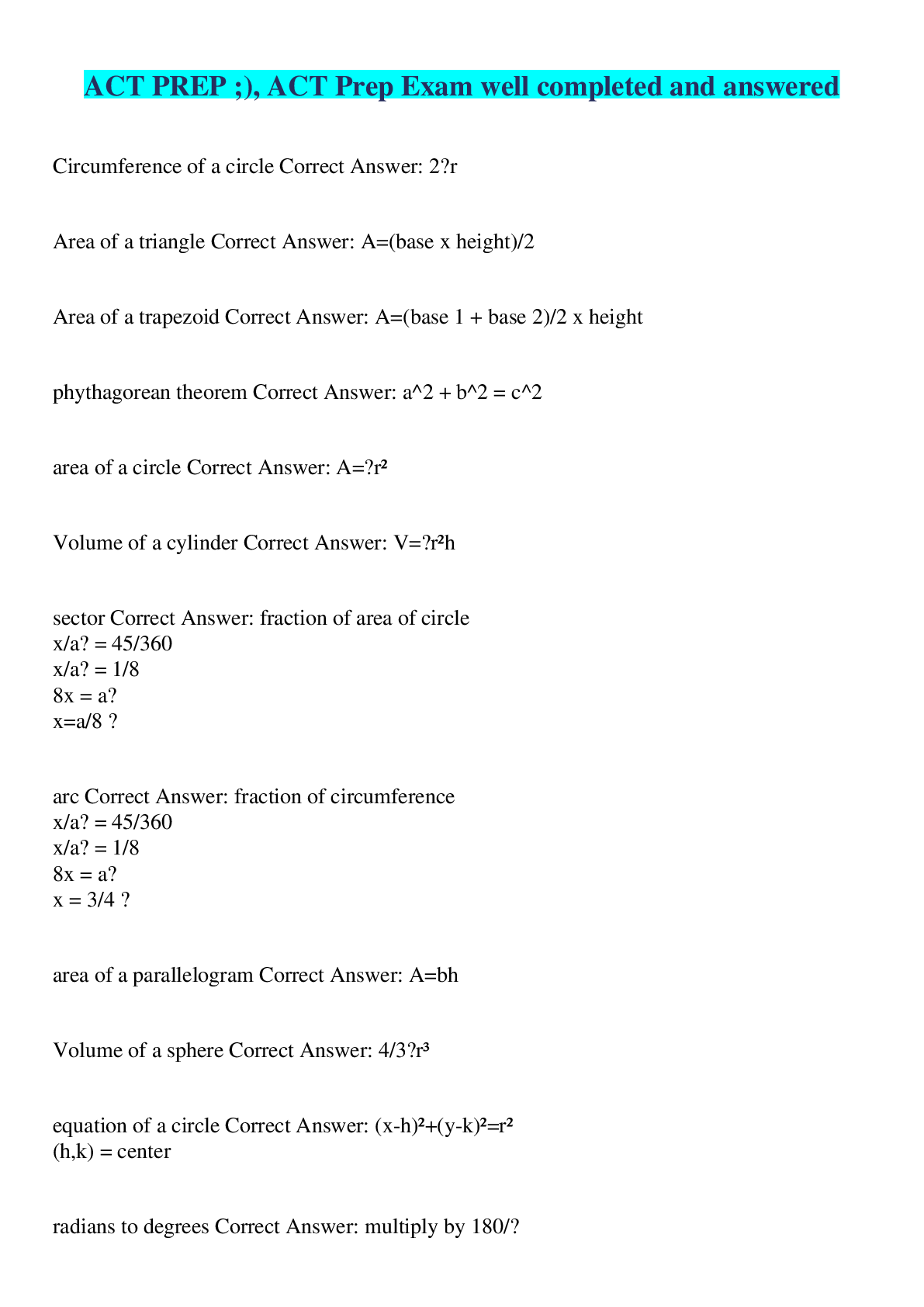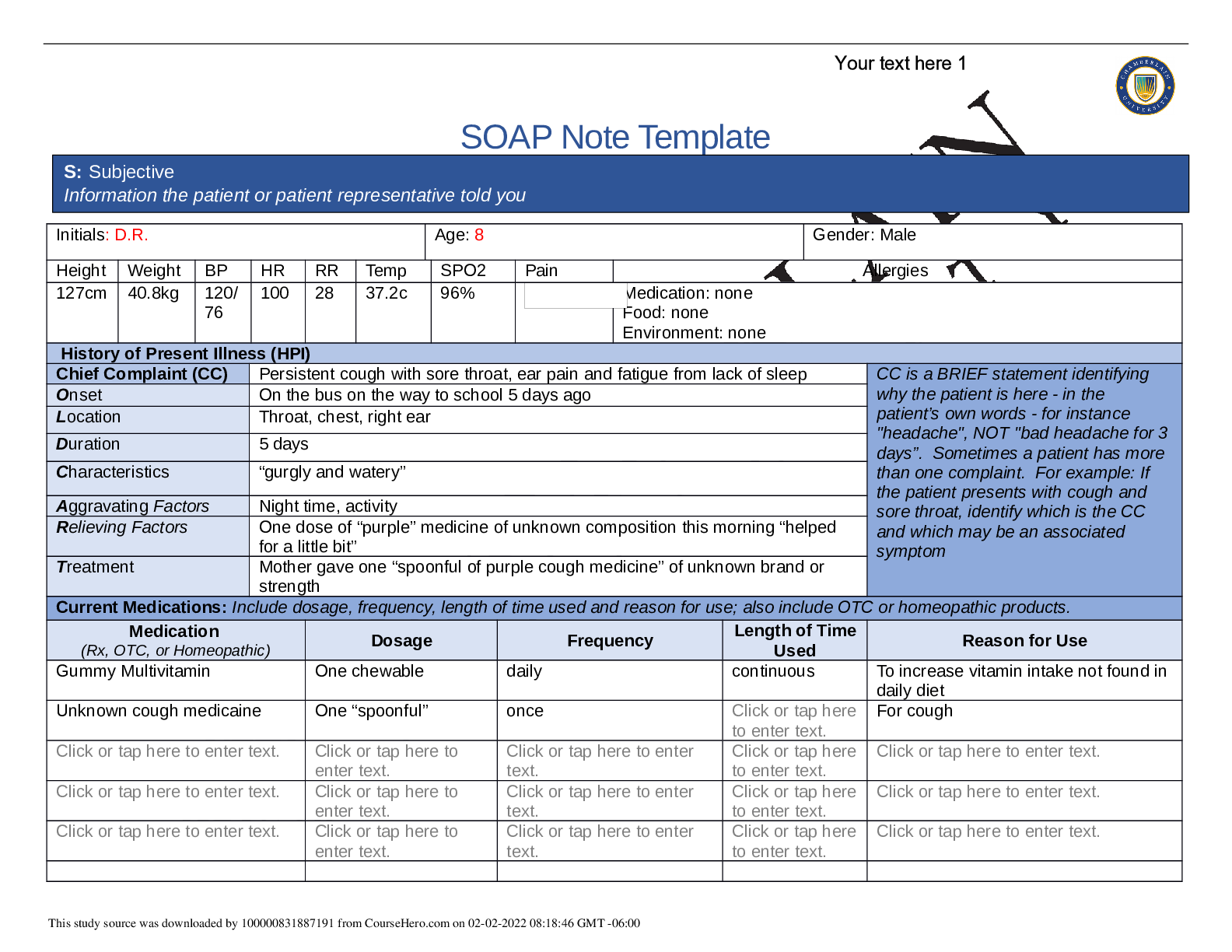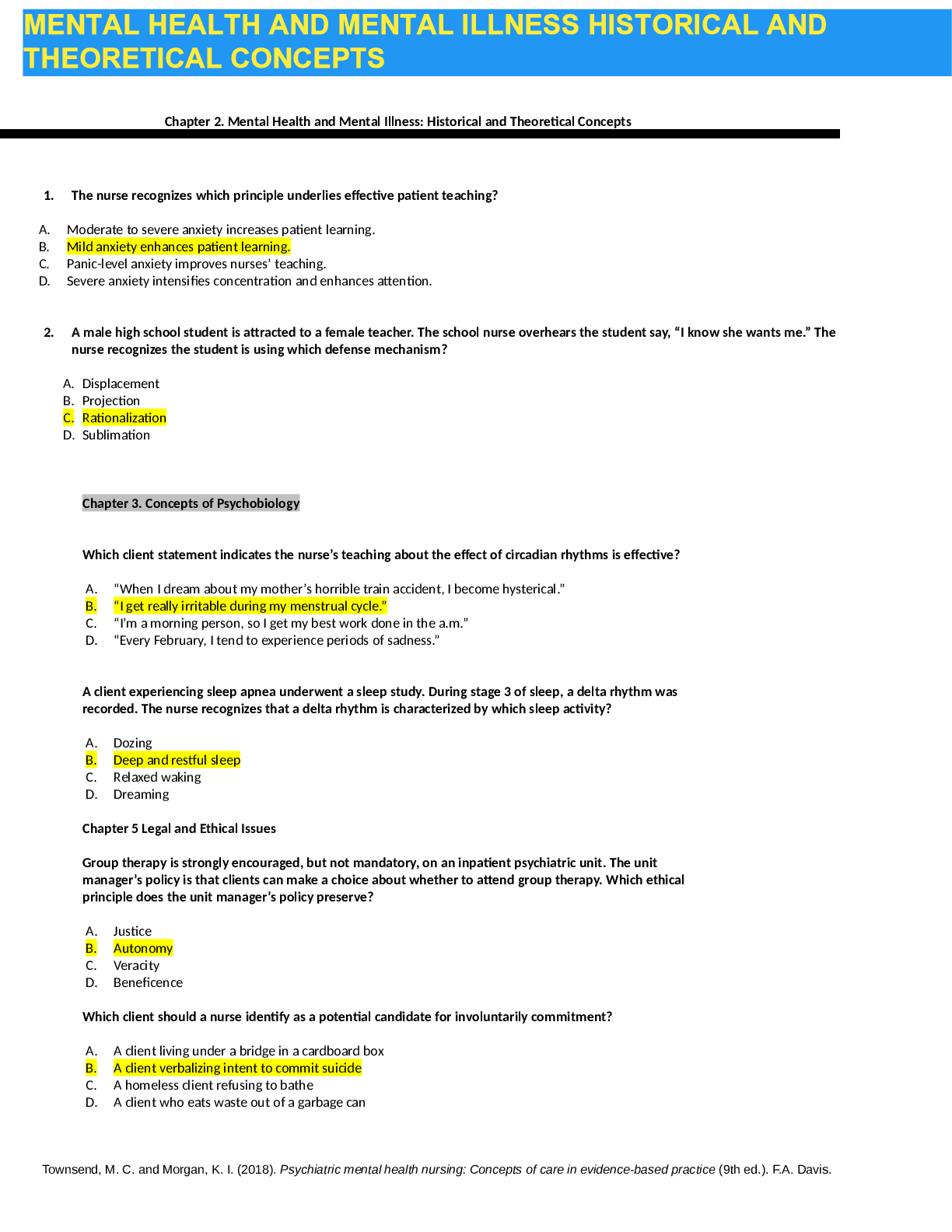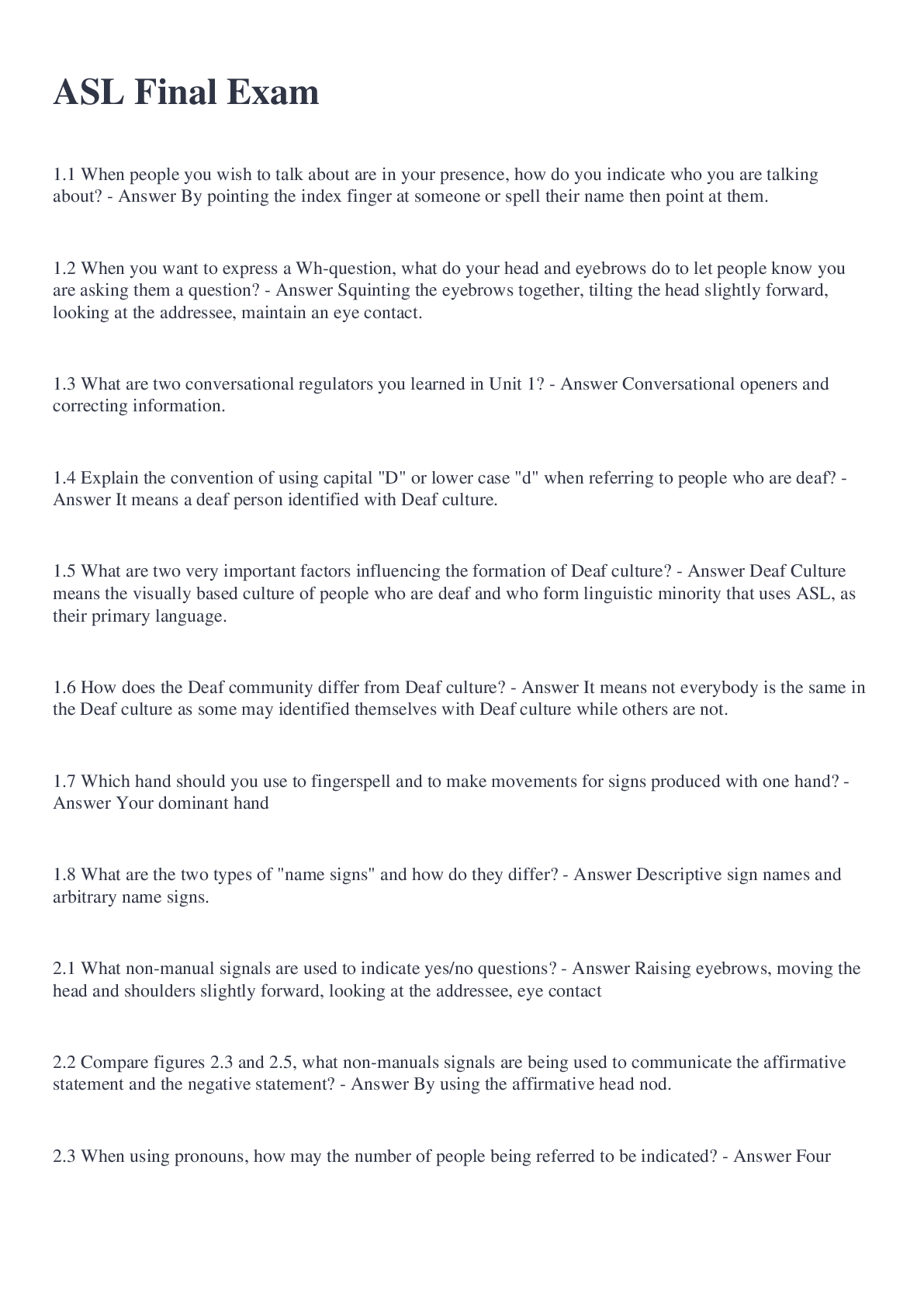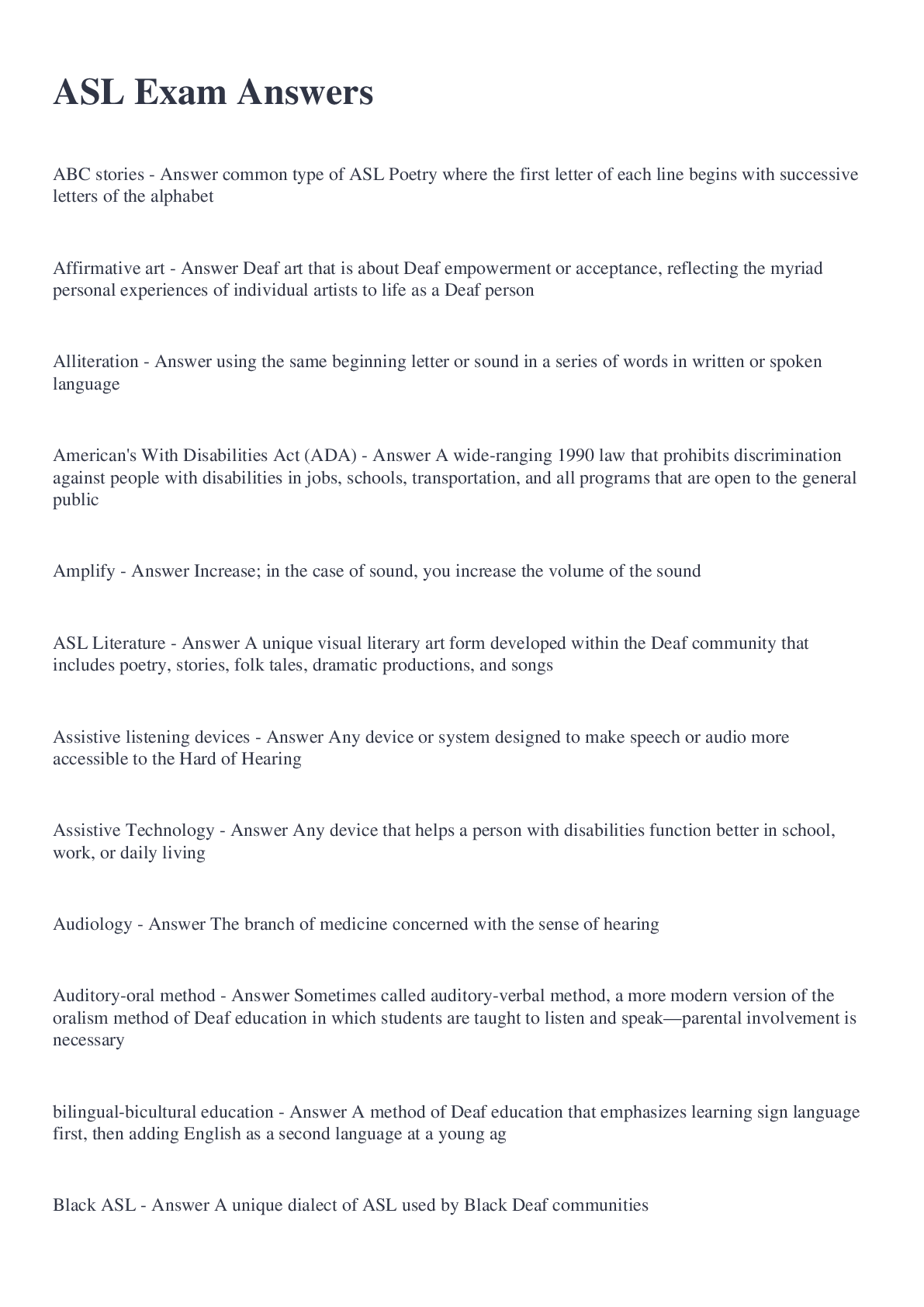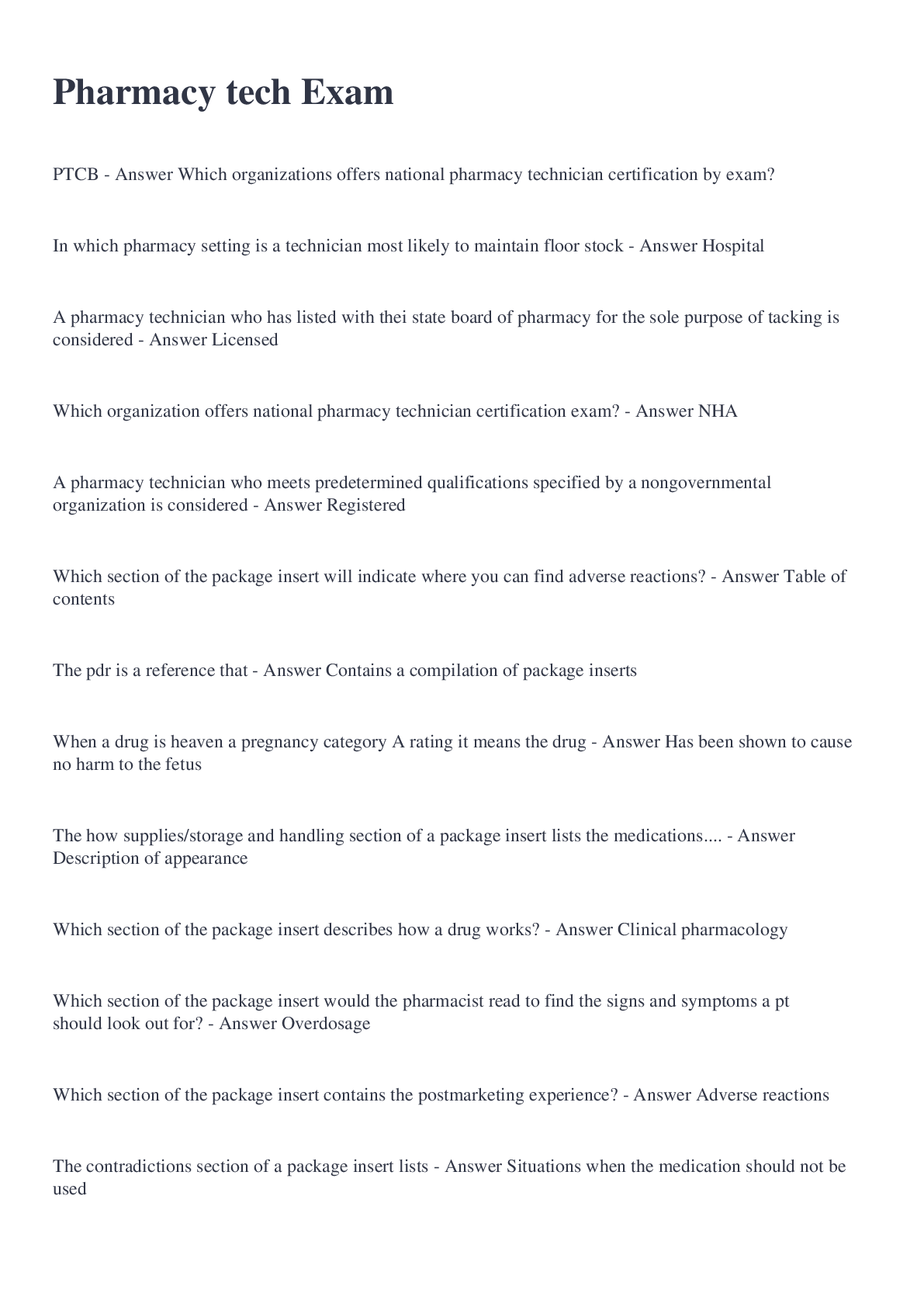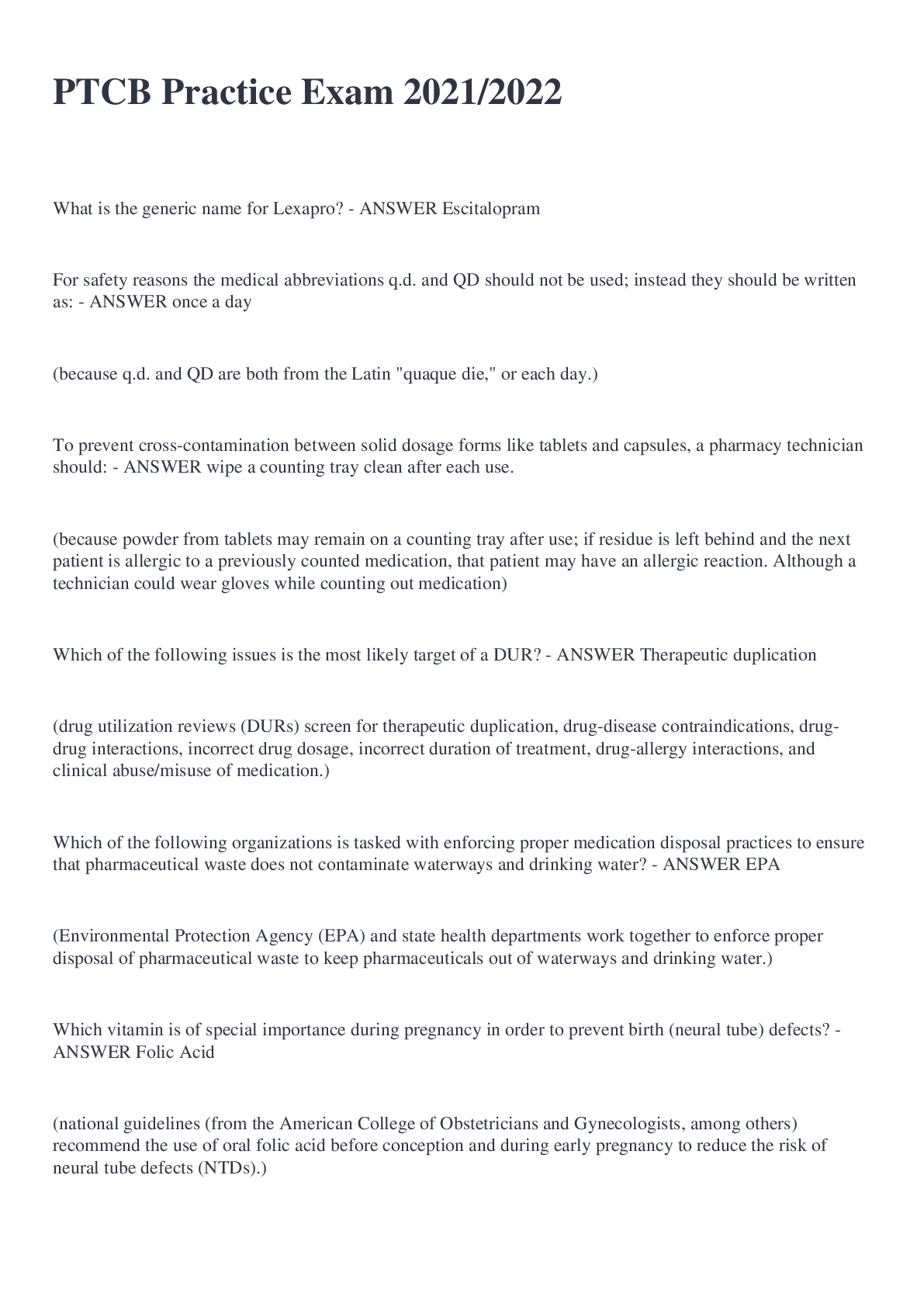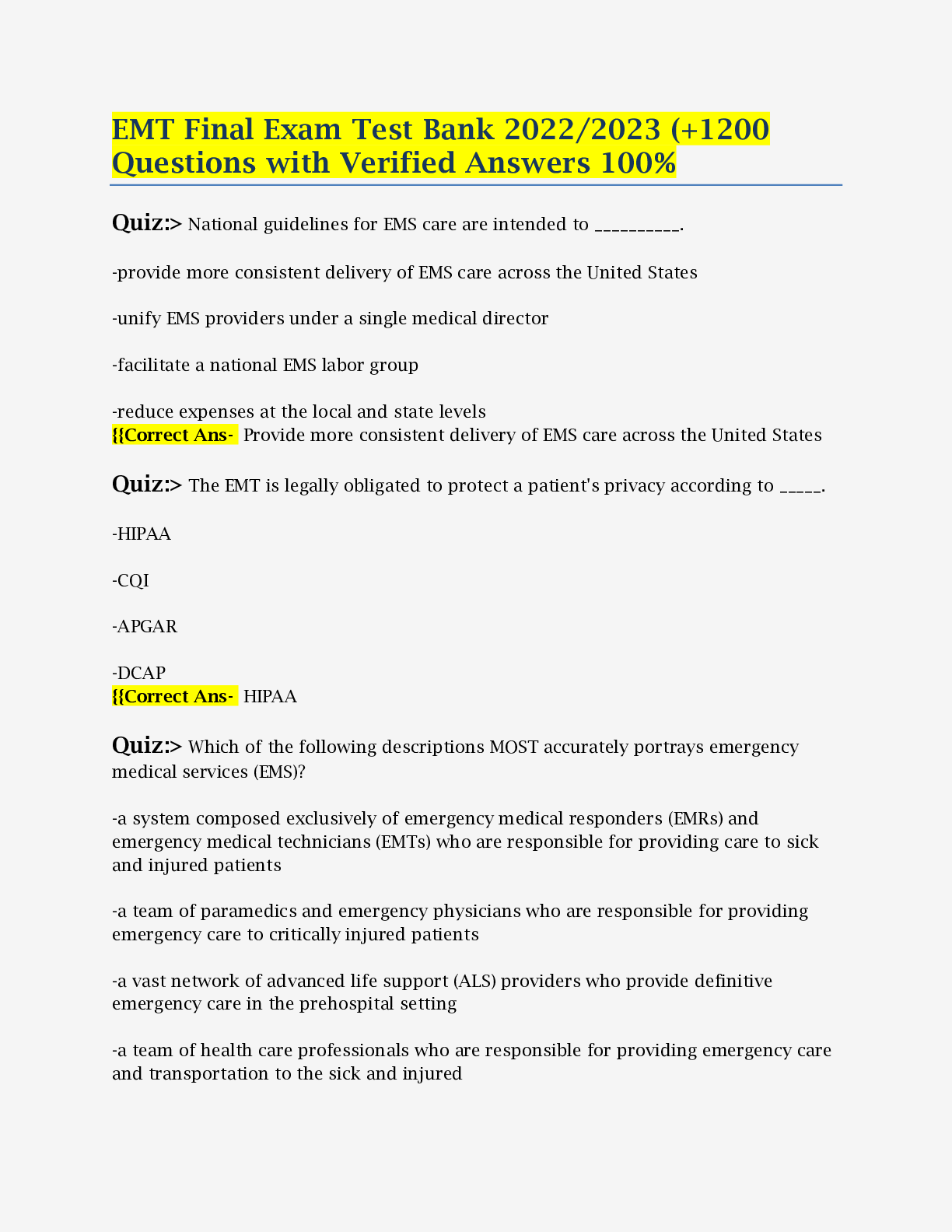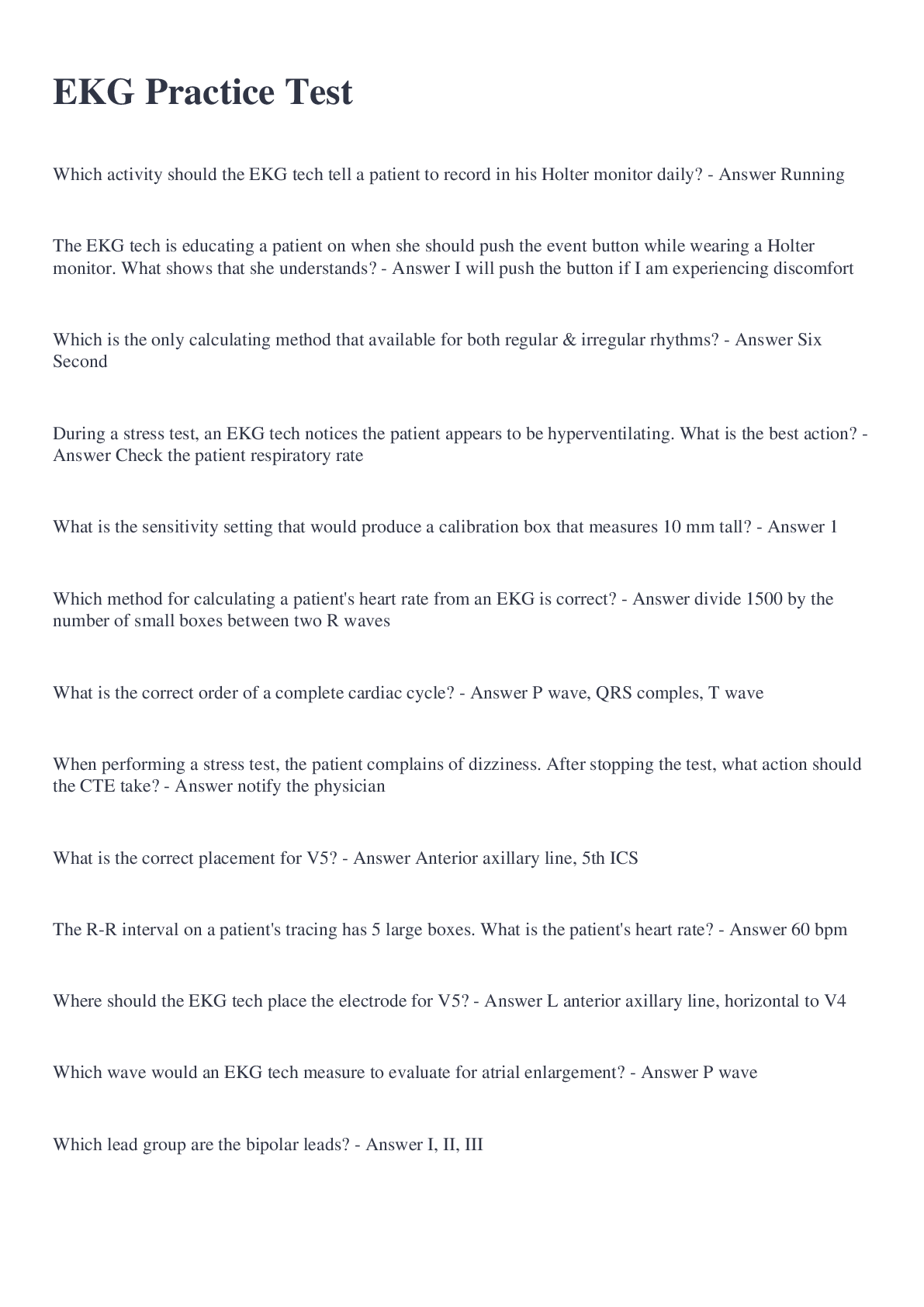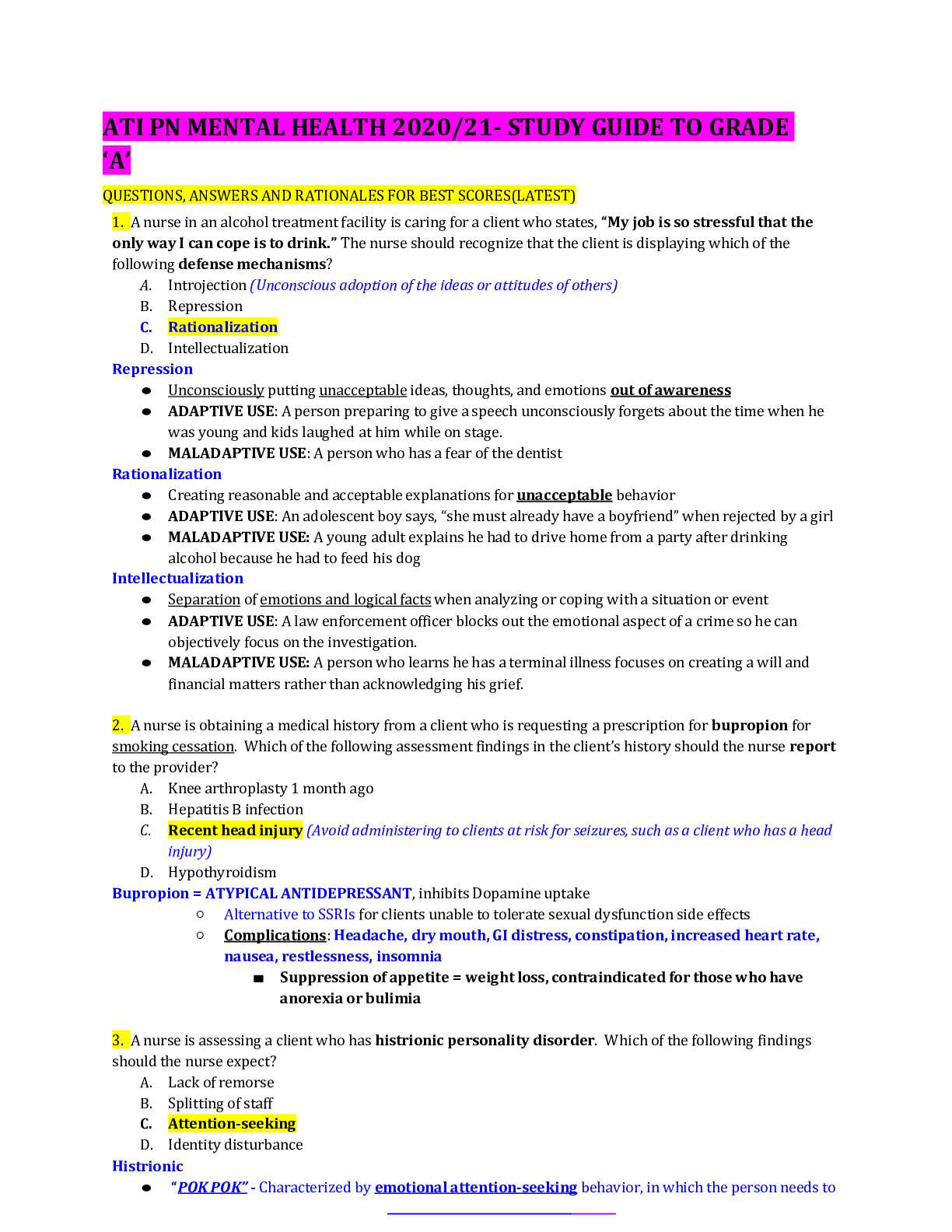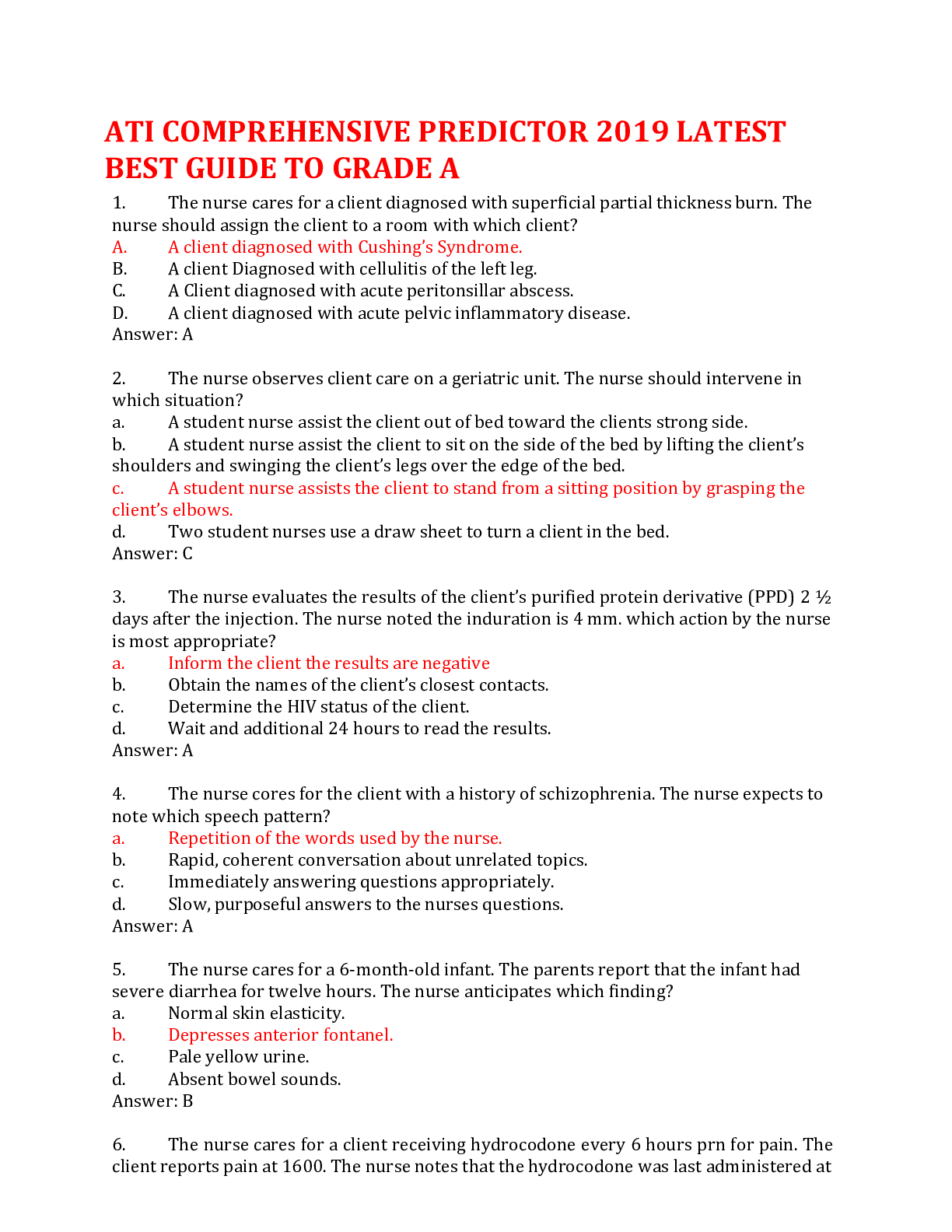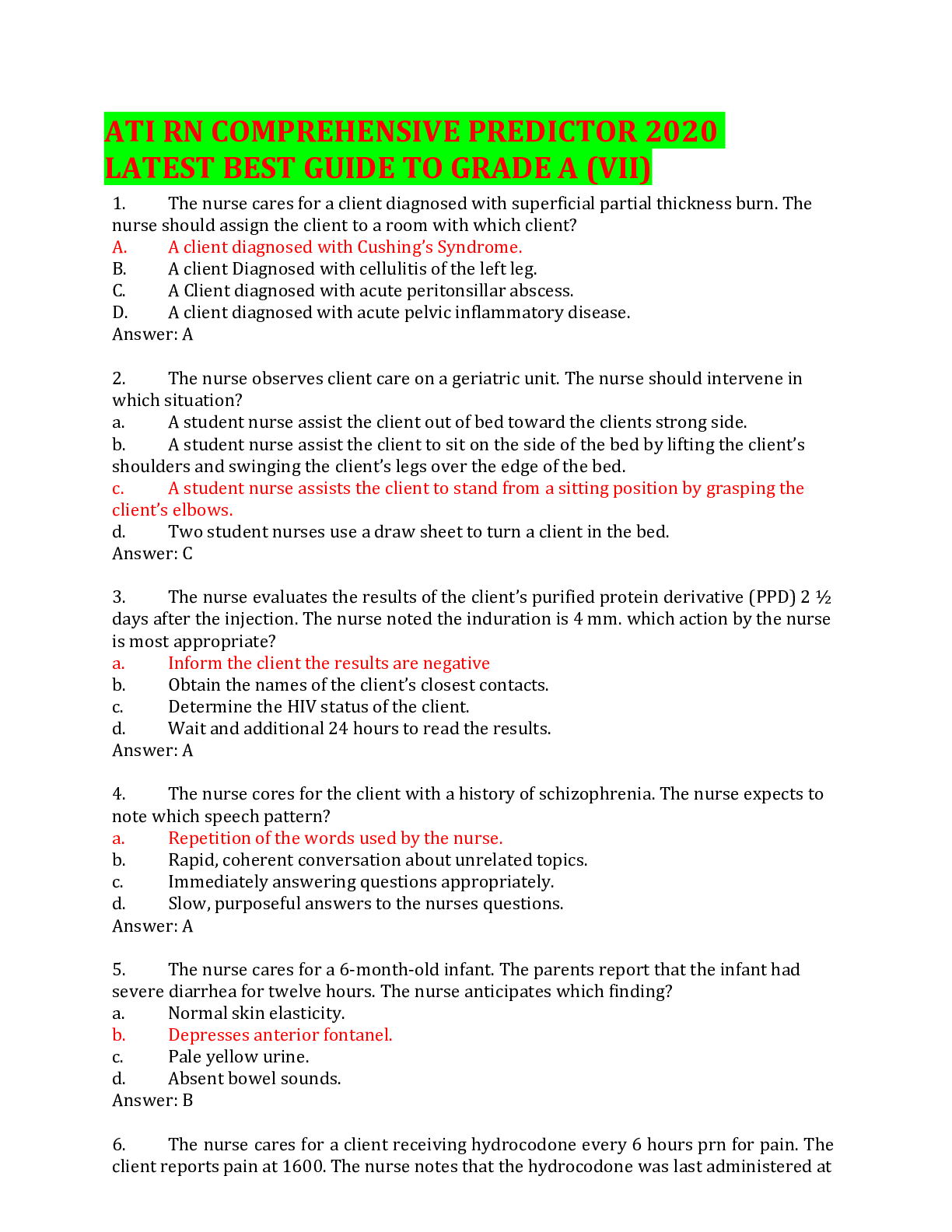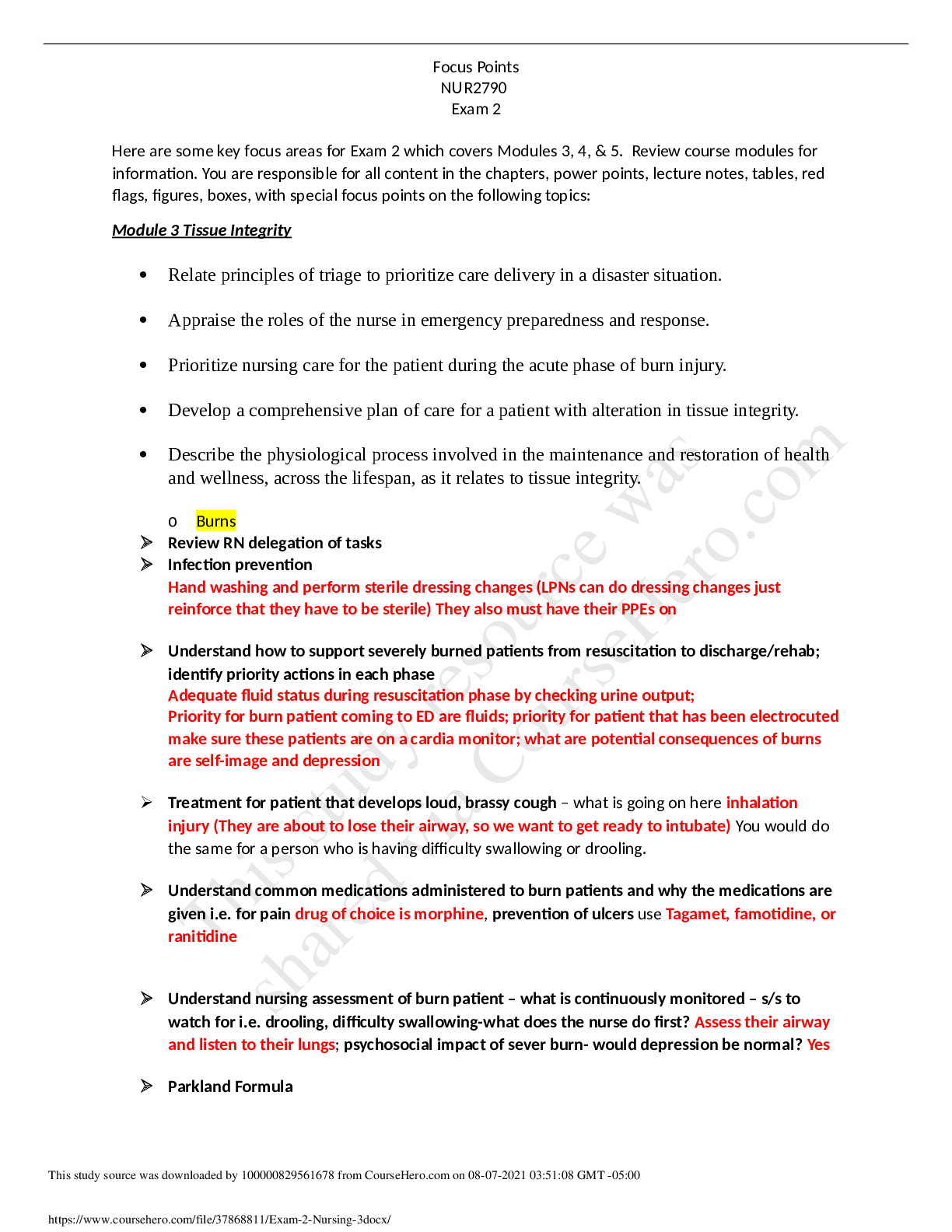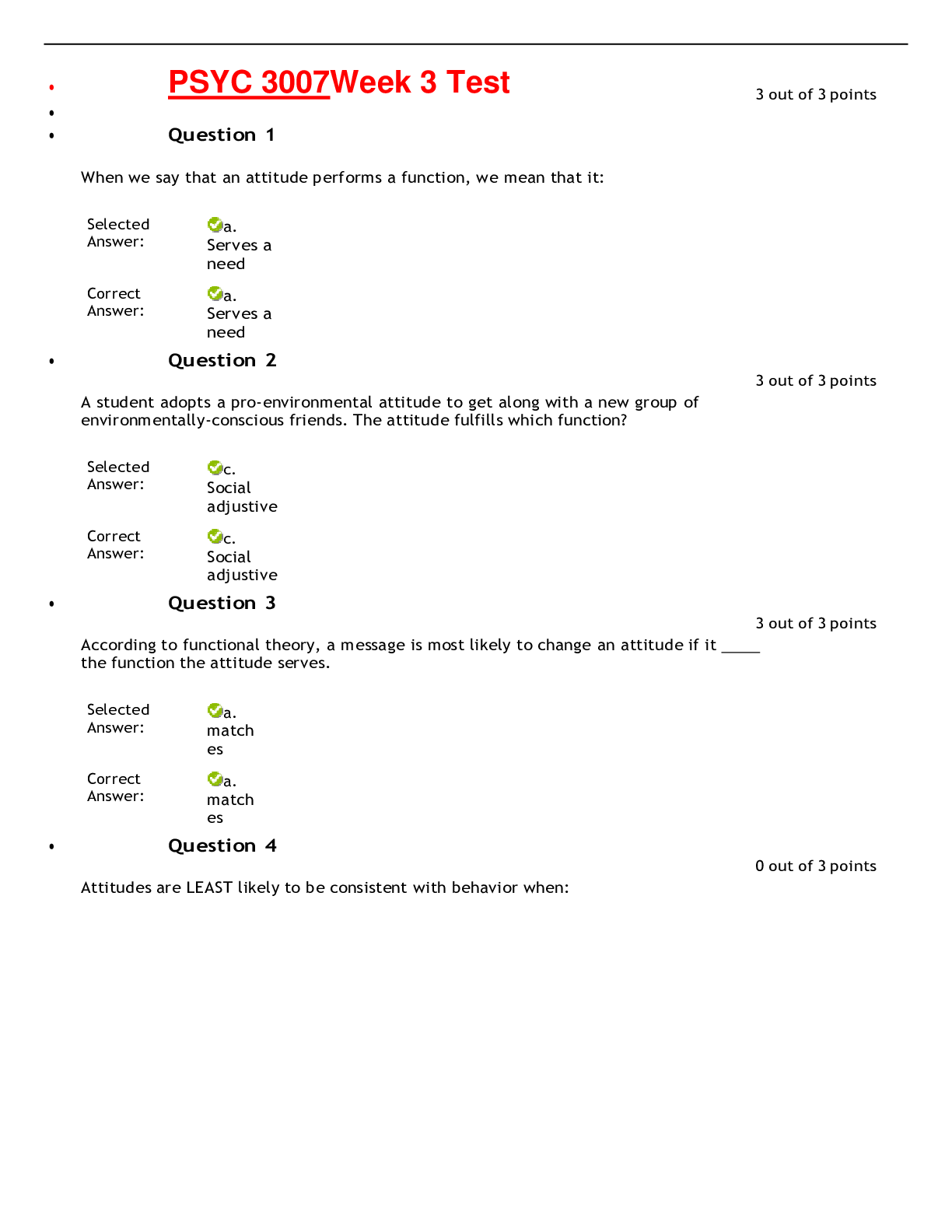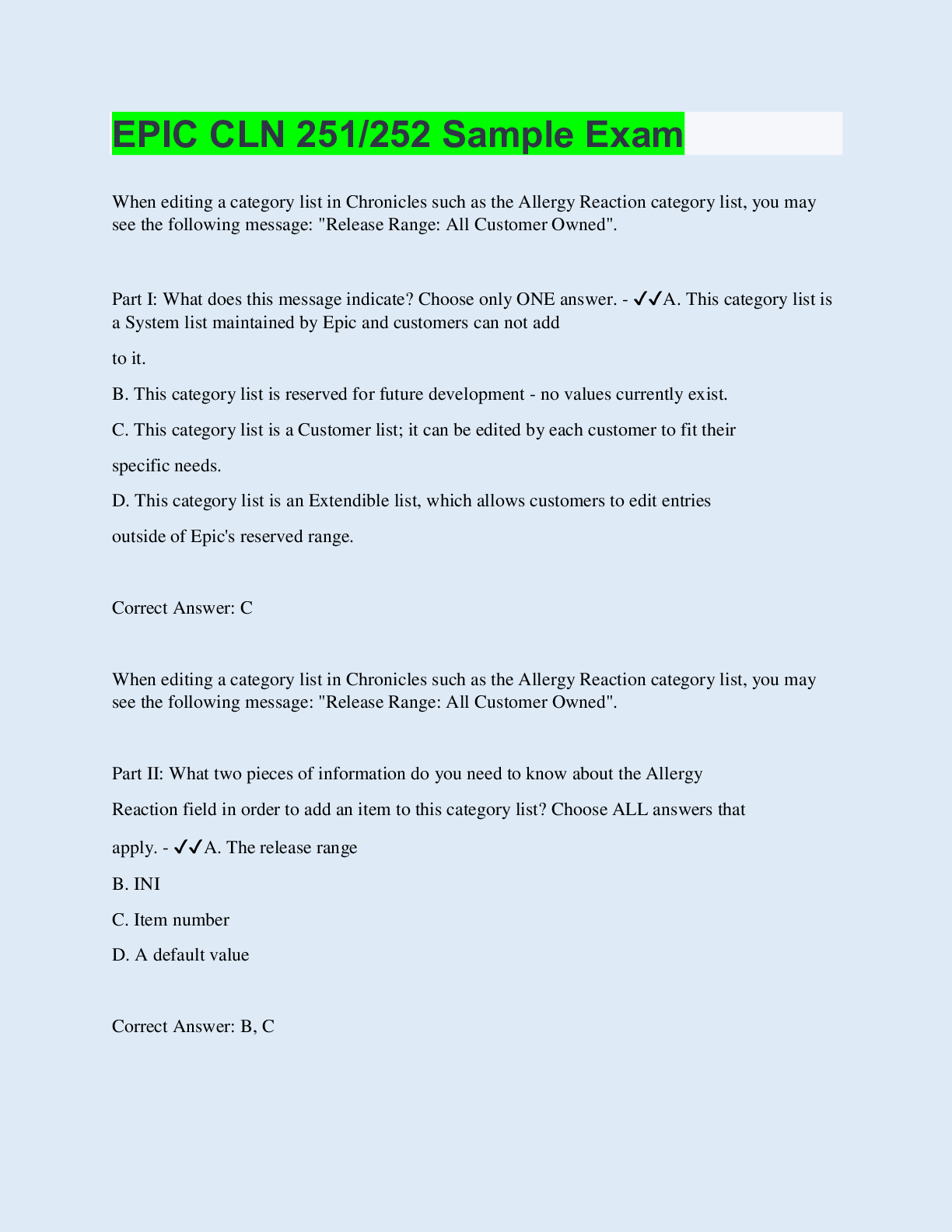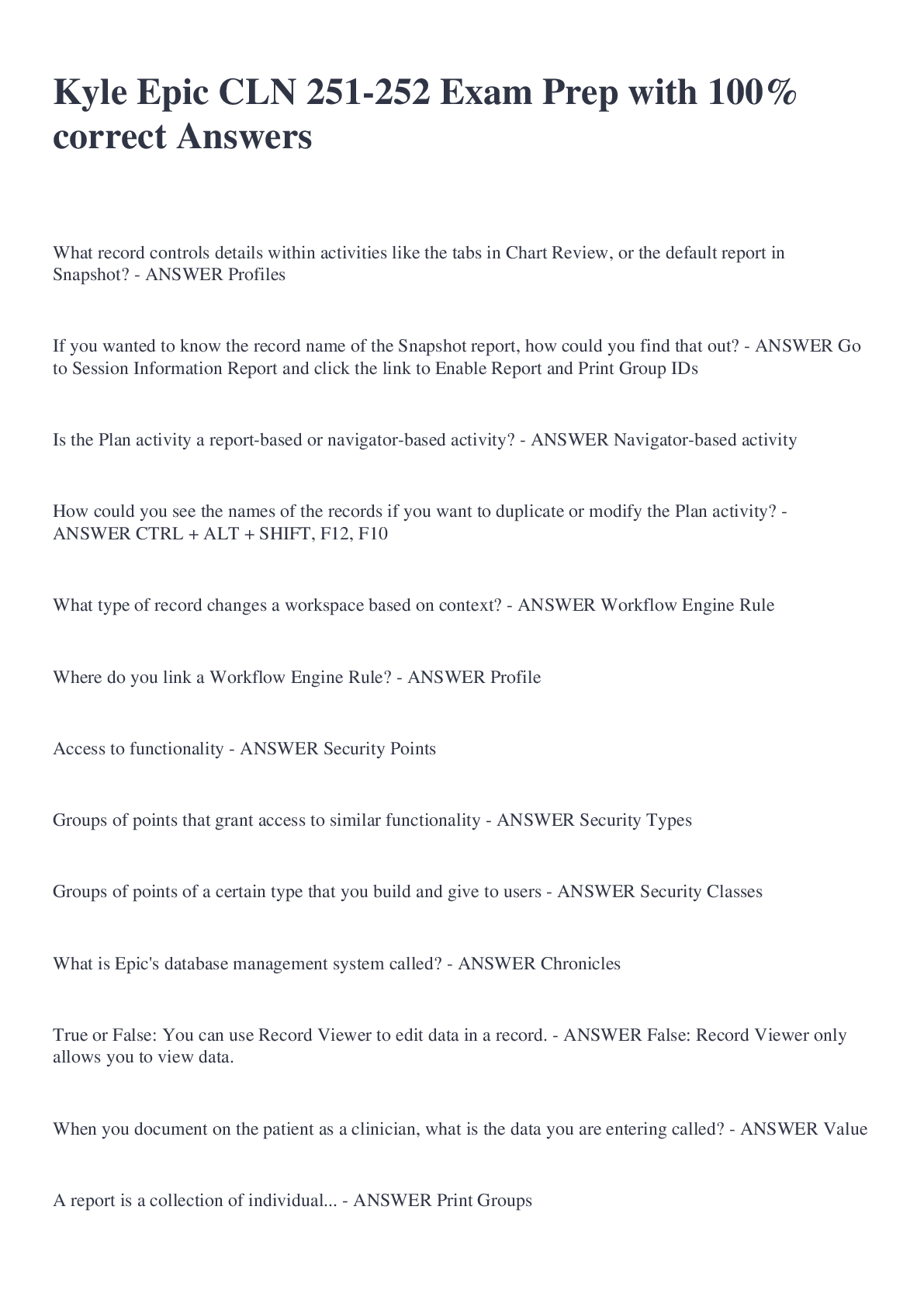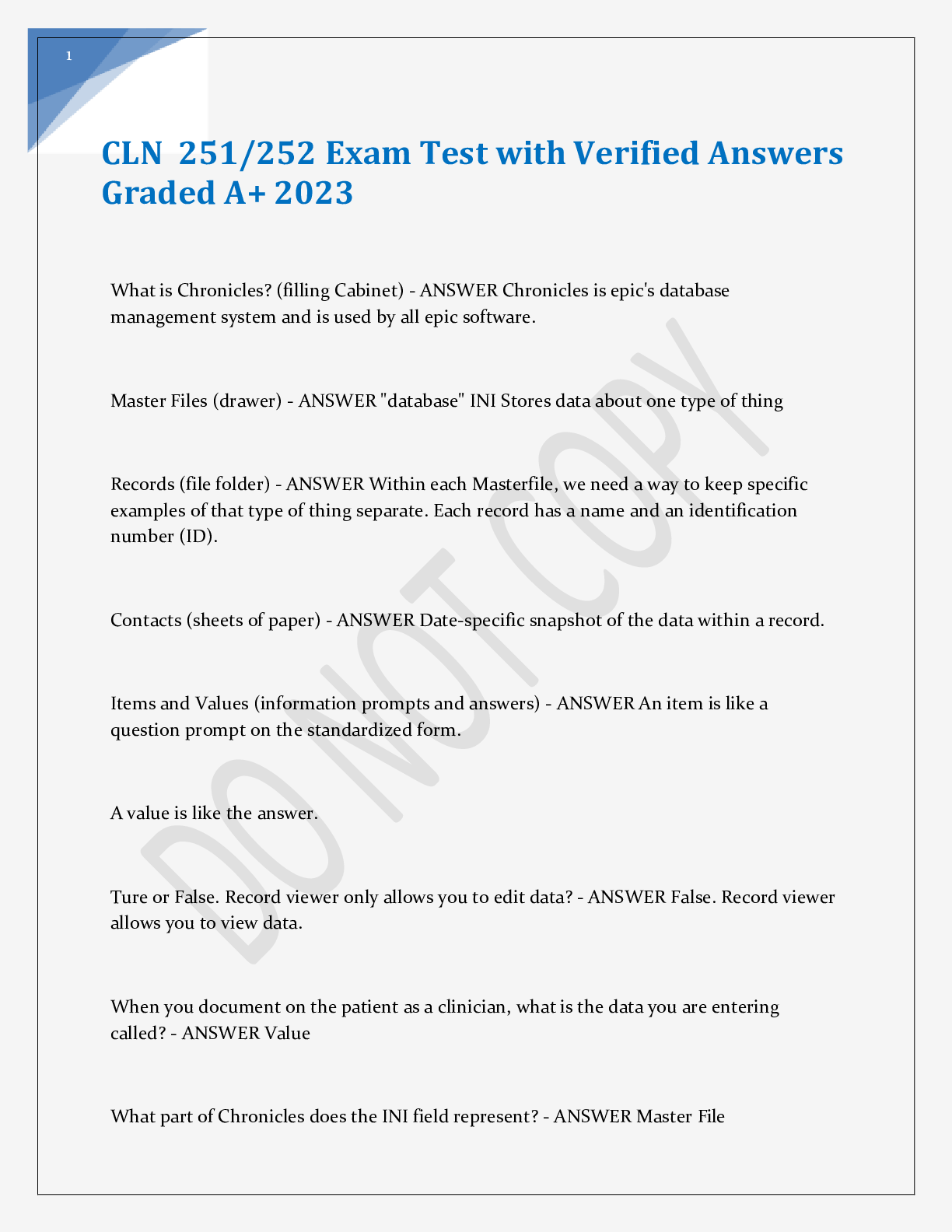*NURSING > EXAM > FUNDAMENTALS OF NURSING LATEST REVISION GUIDE BEST REVISION GUIDE TO GRADE A (All)
FUNDAMENTALS OF NURSING LATEST REVISION GUIDE BEST REVISION GUIDE TO GRADE A
Document Content and Description Below
FUNDAMENTALS OF NURSING LATEST REVISION GUIDE BEST REVISION GUIDE TO GRADE A 1 A nurse is assessing for early signs of compartment syndrome for a client who has a short-leg fiberglass cast. Which of t... he following findings should the nurse expect? A. Capillary refill less than 2 seconds B. Bounding distal pulses C. Intense pain with movement D. Erythema of the toes 2 A nurse is monitoring a client who is receiving 2 units packed RBCs. Which of the following manifestations indicates a hemolytic transfusion reaction? A. Chills B. Hypertension C. Bradycardia D. Back pain 3 A nurse is caring for a client who had a total hip arthroplasty. Which of the following actions should the nurse take to prevent hip dislocation? A. Remove the wedge device when turning B. Place two bed pillows between the legs when in bed C. Encourage the client to lean forward when attempting to stand D. Elevate the knees higher than the hips when sitting 4 A nurse is assessing a client who is preoperative and reports an allergy to bananas. The nurse should recognize that the client is at risk for an allergic cross-reactivity to which of the following substances A. Povidone-iodine B. Adhesive tape C. Latex D. Anesthetics 5 A nurse is teaching a client about the use of an incentive spirometer. Which of the following instructions should the nurse include in the teaching? A. Place hands on the upper abdomen during inhalation. B. Position the mouthpiece 2.5 cm (1 in) from the mouth C. Exhale slowly through pursed lips D. Hold breaths about 3 to 5 seconds before exhaling 6 A nurse is caring for a client who arrives at the emergency department and reports vomiting and diarrhea for the past 3 days. The client’s serum potassium level is 2.8mEq/L. Which of the following interventions should the nurse implement first? 7 A nurse is preparing to administer peritoneal dialysis to a client. Which of the following actions should the nurse take? A. Chill the dialysate before administration B. Hang the drainage bag below the client’s abdomen C. Place the client in high-Fowlers position D. Use clean technique to access the catheter 8 A nurse is preforming a cranial nerve assessment on a client following a head injury. Which of the following findings should the nurse expect if the client has impaired function of the vestibulocochlear nerve (cranial nerve VIII)? A. Inability to smell B. loss of peripheral vision C. Disequilibrium with movement D. Deviation of the tongue from midline 9 A nurse is planning care for a client who is one day postoperative Following an open cholecystectomy. Which of the following interventions should the nurse include in the plan of care? A. Place pillows under the clients knees B. Avoid use of anticoagulants C. Discourage leg exercises while in bed D. apply compression stockings to the lower extremities 10 A nurse is caring for a male client who has an exacerbation of heart failure. Which of the following prescriptions should the nurse expect to receive from the provider? (click on the “exhibit” button for additional information about the client. There are 3 tabs that contain separate categories of data.) A. Atropine 1mg IV bolus every 5 min up to 3 mg ? B. Adenosine 6mg rapid IV bolus now C. Verapamil 80 mg PO TID D. Furosemide 40 mg IV bolus every 6 hr. 11 A nurse is providing a discharge teaching to a client following a modified left radical mastectomy with breast expander. Which of the following statements by the client indicates an understanding of the teaching? A. “I will keep my left arm flexed at the elbow as much as possible” ? B. “ I should expect less than 25 mL of secretions per day in the drainage devices” C. “I will perform strength building arm exercises using a 15 pound weight” D. “ I will have to wait 2 months before additional saltine can be added to my breast expander” 12 A nurse is teaching a client about using a metered-dose rescue inhaler. Which of the following statements should the nurse include I the first teaching? A. “Do not shake your inhaler before use” B. “Exhale Fully before bringing the inhaler to your lips “ C. “Use Peroxide to clean the mouthpiece of your inhaler” D. “Depress the canister after you inhale” 13 A nurse is caring for a client who has been receiving total parental nutrition (TPN) for 1 week. For which of the following findings should the nurse notify the provider? A. Calcium level 11.5 mg/dL B. Serum albumin level 3.9g/dl C. Output 200 mL more than intake over the past 12 hr. D. Fasting blood glucose level 105 mg/dL 14 A nurse is preparing to discharge a client who has a halo device and is reviewing new prescriptions from the provider. The nurse should clarify which of the following prescriptions with the provider? 15 A nurse is setting up a sterile field before preforming a dressing change on a client who is postoperative. Which of the following actions should the nurse plan to take to maintain the sterile field? (Select all that apply 16 A nurse is an emergency department is preparing a client for emergency surgery. The clients blood alcohol level is 180mg/dL. Which of the following actions is the nurse’s priority? 17 A nurse is assessing a client who has increased intracranial pressure. The nurse should recognize that which of the first sign of deteriorating neurological status? A. Pupillary dilation B. Cheyne-Strokes respirations C. Decorticate posturing D. Altered level of Consciousness 18 A nurse is performing skin cancer screening on a group of clients. Which of the following findings should the nurse Identify as an indication of melanoma? A. Flat lesion with irregular borders B. Raised lesion with a rolled border C. Scaly lesion with the crusted appearance D. Reddened lesion with dilated blood vessels 19 A nurse is caring for a client who has diabetes insipidus. Which Of the following medications should the nurse plan to administer. A. Lithium B. Desmopressin C. Regular insulin D. Furosemide 20 A nurse is preparing to assist with the insertion of a non-tunneled Central venous catheter for a client who is malnourished. Which of the following actions should the nurse plan to take. A. Cleanse the site with a hydrogen peroxide solution B. instruct the client to cough as the catheter is inserted C. confirm the correct position of the line by obtaining a blood sample D. place the head of the client's bed lower than the foot ??? 21 A nurse is caring for a client who had an arterial revascularization of the lower extremity. Which of the following is the priority action the nurse should plan to take after contacting the provider? (Click on the “Exhibit” button for additional information about the client. There are three tabs that contain separate categories of data 22 A nurse is providing discharge teaching to a client who has chronic urinary tract infections. The client has a prescription for ciprofloxacin 250 mg PO twice daily. Which of the following instructions should the nurse include in the teaching? A. Monitor heart rate once daily. B. Take a laxative to prevent constipation. C. Drink 2 to 3 L of fluids daily. D. Take an antacid 30 min before taking the medication. 23 A nurse is providing discharge teaching for a client who has HIV. Which of the following information is the priority for the nurse to review with the client? A. “List some ways you can cope with the stress of your illness” B. “Name a few things you will change about your diet.” C. “Tell me why it’s important to have your CD4+ count checked” D. “Describe your daily medication schedule.” 24 A nurse is administering packed RBCs to a client. The client reports chills, lower back pain, and nausea 10 min after the infusion begins. Which of the following actions should the nurse take first ? A. Stop the infusion. B. Collect a urine sample. C. Check the client’s vital signs. D. Administer oxygen to the client. 25 A nurse is preparing to assist the provider with a thoracentesis for a client who has a left pleural effusion. Which of the following interventions is the priority for the nurse? A. Reinforce the importance of lying still during the procedure. B. Determine whether the client has a allergy to local anesthetics. C. Administer a sedative medication. D. Describe the sensations the client will feel during the procedure. 26 A nurse is caring for a client who has bladder cancer and a WBC count of 900/mm3. Which of the following actions should the nurse take? A. Use contact isolation while providing care. B. Move the client to a negative pressure room. C. Apply pressure to venipuncture pressure room. D. Instruct the client to avoid eating raw fruit. 27 A nurse is reviewing the medical record of a client who is 1 day postoperative following an appendectomy. Which of the following findings should the nurse report to the provider? A. Reports pain of 4 on a scale from 0 to 10 when coughing B. WBC count 8,400/mm3 C. Serosanguineous exudate noted on dressing change D. Hemoglobin 10 mg/ dL 28 A nurse is caring for a client who was admitted with nausea, vomiting, and possible bowel obstruction. An Ng tube is placed and set to low intermittent suction. Which of the following findings should the nurse report to the provider? A. The amount of drainage is gradually decreasing. B. The drainage is bright green in color with brown fecal material. C. The client’s abdomen becomes distended and firm. D. The client reports being extremely thirsty with a sore throat. 29 A nurse is reviewing the medical record of a client who is scheduled for a CT scan with a contrast media. Which of the following medications should the nurse instruct the client to withhold for 48hr following the procedure? A. Carvedilol B. Metformin C. Clopidogrel D. Furosemide 30 A nurse is preparing to perform ocular irrigation for a client following a chemical splash to the eye. Which of the following actions should the nurse plan to take first? A. Instill 0.9% sodium chloride solution into the affected eye. B. Administer proparacaine eye drops into the affected eye. C. Place a strip of PH paper onto the cul-de-sac of the affected eye. D. Collect information about the irritant that caused the injury. 31 A nurse is providing instructions about foot care for a client who has peripheral arterial disease. The nurse should identify that which of the following statements by the client indicates an understanding of the teaching? 32 A nurse is collecting data from a client who has toxoplasmosis and is HIV positive. Which of the following questions should the nurse ask to gather data about toxoplasmosis? A. “Do you have any household pets, such as a cat?” B. “Was anyone in your family recently exposed to a viral disease?” C. “Are your immunizations current?” D. “Have you a been out of the country in the past 30 days?” 33 A nurse in a long-term care facility is caring for a bedridden client. Which of the following findings should alert the nurse to a potential complication of the client’s immobility? A. Polyuria B. Confusion C. Blurred vison D. Diarrhea 34 A nurse is checking a client’s ventilator settings. The nurse should understand that positive end- expiratory pressure has which of the following purposes? A. To deliver a set tidal volume B. To prevent alveolar collapse ??? C. To control the rate of ventilations D. To provide positive airway pressure during inspiration 35 A nurse is caring for a client who is postoperative following a partial thyroidectomy. Which of the following findings is the priority for the nurse to report to the provider? A. Client report of pain at the incision site B. Loose tracheal secretions C. Hypoactive bowel sounds D. High-pitched sound on inspiration 36 A nurse on a medical unit is planning care for a group of clients. Which of the following clients should the nurse attend to first? A. A client who has chronic obstructive pulmonary disease and an oxygen saturation of 89% B. A client who has left-sided paralysis and slurred speech from a prior stroke C. A client who has multiple sclerosis and reports ataxia and vertigo D. A client who has thrombocytopenia and reports a nosebleed. 37 A nurse is caring for a client who has a newly inserted chest tube. The nurse should clarify which of the following prescriptions with the provider A. Vigorously strip the chest tube twice daily. B. Notify the provider when tiddling ceases. C. Administer morphine 2 mg IV bolus every 3hr PRN for pain. D. Assist the client out of bed three times daily 38 A nurse is planning care for a client who has a newly implanted arteriovenous graft in the right arm. Which of the following actions should the nurse include in the pan of care? A. Instruct the client to avoid lifting the right arm for 72hr B. Check blood pressure in the right arm C. Insert a saline lock into a site 10 cm (4 in) distal to the graft D. Palpate the site for a thrill 39 A nurse is providing discharge teaching for a client who has osteomyelitis in the left leg. Which of the following findings should the nurse identify as requiring a referral? A. The client has a prescription for a furosemide B. The client has a prescription for long term IV antibiotic therapy C. The client has a WBC count of 20,000/mm3. D. The client has type 2 diabetes mellites and HDA1C of 5 %. 40 A nurse is caring for a client who has an IV in the left forearm and whose infusion pump has alarmed several times. Which of the following actions should the nurse take first? A. Ensure the tubing connections are secure B. Reposition the client’s left arm C. Flush the IV catheter D. Check the IV site for redness ????? 41 A nurse is caring for a client who is 6hr postoperative following application of an external fixator for a tibial fracture. Which of the following actions should the nurse take? A. Maintain the affected extremity in a dependent position B. Wrap sterile gauze on the sharp point of the pins C. Adjust the clamps on the fixator frame D. Palpate the dorsalis pedis pulse. 42 A nurse is caring for a client following a total knee arthroplasty. The client reports a pain level on a pain scale of 0 to 10. Which of the following interventions should the nurse take? A. Place pillows under the client’s knee B. Gently massage the area around the client’s incision C. Apply an ice pack to the client’s knee D. Perform range-of-motion exercises to the client’s knee 43 A nurse is teaching a client and his partner about performing peritoneal dialysis at home. When discussing peritonitis, which of the following manifestations should the nurse identify as the earliest indication of this complication? A. Fever B. Cloudy effluent C. Increased heart rate D. Generalized abdominal pain 44 A nurse in a emergency department is caring for a client who is to receive tissue plasminogen activator (TPA) for the treatment of an ischemic stroke. In which order should the nurse complete the following actions? (Move the steps into the box on the right, placing them into the selected order of performance. Use all the steps.) 45 A nurse in the emergency department admitted a client who is having a myocardial infarction. The client has been placed on the heart monitor. Which of the following electrocardiogram strips is indicative of a myocardial infraction? 46 A nurse is assessing a client who has acute pancreatitis and has been receiving a total parenteral nutrition for the past 72hr. Which of the following findings requires the nurse to intervene? priority A. Capillary blood glucose level 164 mg/dL B. Crackles in bilateral lower lobes C. WBC count 13,000/mm3 D. Right upper quadrant pain 47 A nurse is caring for a group of clients. The nurse should obtain a blood pressure reading using only the left extremity for which of the following clients? A. A client who has a right upper extremity arteriovenous fistula B. A client who has left-sided Bell’s pal C. A client who has right-sided weakness due to Parkinson’s disease D. A client who has a peripherally inserted central catheter (PICC) in the left arm 48 A nurse is caring for a client in diabetic ketoacidosis (DKA). Which of the following is the priority intervention by the nurse? A. Administer 0.9% sodium chloride B. Initiate a continuous IV insulin infusion C. Check potassium levels. D. Begin bicarbonate continuous IV infusion 49 A nurse is preparing to administer levofloxacin 750 mg via intermittent over 90 min to a client. Available is levofloxacin 750 mg/150mL. How many mL/hr should the nurse set to the IV pump to administer? (Round to answer to the nearest whole number. Use a leading zero if it applies. Do not use a trailing zero.) 50 A nurse is caring for a client who has been prescribed an antibiotic. The client tells the nurse. “I don’t like taking medications because I don’t think I need them.” Which of the following responses should the nurse make? A. ‘If you don’t take this medication, you will feel worse.” B. “Most clients feel better after taking the antibiotic.” C. “Your provider wouldn’t prescribe this medication if it weren’t necessary’’ D. “I will tell your provider that you do not want to take this medication” 51 A nurse is teaching the family of a client who has Alzheimer’s disease about caring for the client at home. Which of the following instructions should the nurse include? A. Cover electrical outlets in the client’s home with tape. B. Keep the client’s bedroom dark at night. C. Hang a monthly calendar in the client’s bedroom D. D. Place a large-face clock in the client’s bedroom 52 A nurse is assessing the pain status of a group of clients. Which of the following findings indicates a client is experiencing referred pain? A. A client who has peritonitis reports generalized abdominal pain. B. A client who is postoperative reports incisional pain. C. A client who has angina reports substernal chest pain. D. A client who has pancreatitis reports pain in the lef t shoulder. 53 a nurse is reviewing the medical record of a client who is to undergo open heart surgery. Which of the following findings should the nurse report to the provider as a contraindication to receiving heparin? A. Rheumatoid arthritis B. Thalassemia C. COPD D. Thrombocytopenia 54 A nurse is reviewing the medical record of a client to identify risk factors for colorectal cancer. The nurse should identify which of the following findings as increasing the client’s risk? A. History of Crohn’s disease B. BMI of 24 C. Diet high in fiber D. Age 46 years 55 A nurse is completing discharge teaching with a client who has a peripherally inserted central catheter (PICC) line in the left arm. Which of the following instructions should the nurse include in the teaching? A. Do not elevate the arm above the level of the heart B. Use a 10-mL syringe to flush the line C. Change the catheter dressing daily D. Clean the insertion site using 20 mL of hydrogen peroxide 56 A nurse is preparing to administer daily medications to a client who is undergoing a procedure at 1000 that requires IV contrast dye. Which of the following routine medications to give at 0800 should the nurse withhold? A. Metoprolol B. Fluticasone C. Metformin D. Valproic acid 57 A nurse is caring for a client who has developed a heart rate of 38/min and reports tremors and feeling faint. Which of the following medications should the nurse anticipate administering? A. Digoxin B. Atropine sulfate C. Diltiazem D. Magnesium sulfate 58 A nurse is reviewing the medical record of a client who has pneumonia. Which of the following serum laboratory values should the nurse expect? A. Hematocrit 35% B. Sodium 130 mg/dL C. WBC count 15,000/mm3 D. BUN 8 mg/dL 59 A nurse in an emergency department is caring for a client who has sinus bradycardia. Which of the following actions should the nurse take first? A. Prepare the client for temporary pacing B. Initiate IV fluid therapy for the client C. Administer atropine to the client D. Measure the client’s blood pressure 60 A nurse is caring for a client who has tuberculosis and is taking rifampin. The client reports that her saliva has turned red orange in color. Which of the following responses should the nurse make? A. “You will need to increase your fluid intake to resolve this problem.” B. “This finding may indicate possible medication toxicity.” C. “This is an expected adverse effect on this medication.”????? D. “Your provider will prescribe a different medication regimen.’’ 61 A nurse is providing discharge teaching about foot care to a client who is newly diagnosed with type 1 diabetes mellitus. Which of the following information should the nurse include? A. Inspect the feet every other day B. Apply lotion between the toes. C. Soak the feet twice a day D. Trim toenails straight across 62 A nurse is reviewing the following ABG results for a postoperative client pH 7.27.PaCO2 49 mm Hg HCO3 22mEq/L. The nurse should interpret the findings as which of the following imbalances? A. Metabolic acidosis B. Metabolic alkalosis C. Respiratory alkalosis D. Respiratory acidosis 63 A nurse is caring for a client who has amnesia. Which of the following assessment findings should the nurse anticipate with the clients conditions. A. Flushed skin color B. Bradycardia C. Heat intolerance D. Headache 64 A nurse is providing discharge teaching to a client who has heart failure and instructs him to limit sodium intake to 2g per day. Which of the following statements by the client indicates an understanding of the teaching? A. “I can season my food with garlic and onion salts.” B. “I can have a frozen fruit juice bar for dessert.” C. “I can have mayonnaise on my sandwich.” D. “I can drink Vegetable juice with a meal.” 65. A nurse on an oncology unit is caring for a client who is receiving internal radiation therapy. Which of the following actions should the nurse take? A. Allow visitors to hold the clients hand. B. Leave the door to the clients room open C. Place the dosimeter film badge on the clients door D. Wear a lead around the apron when providing client care 66. A nurse is assessing a client for a positive Chvostek’s sign following a thyroidectomy. Which of the following areas on the clients head should the nurse tap to assess the client for tetany? 67. A nurse is a group of clients who have cancer about radiation therapy. Which of the following activities should the nurse include in the teaching A. Limit engaging in sport activities that can cause bruising B. Decrease intake of fresh fruits and vegetables C. Limit socializing in large crowds D. Decrease time spent outdoors 68. A nurse is planning care for a client who is receiving heparin IV to treat a pulmonary embolism. Which of the following medications should the nurse plan to have at the bedside? A. Acetylcysteine B. Flumazenil C. Protamine sulfate D. Vitamin K 69. A nurse is providing discharge teaching to a client who has ileostomy. Which of the following client statements indicates an understanding of the teaching. A. “I will empty my bag when it is full.” B. “I will take a laxative when I am constipated.” C. “I will eat a high fiber diet.” D. “I will expect my stools to be loose.” 70. A nurse is reviewing a client’s cardiac monitor for dysrhythmias. Which of the following findings should the nurse identify as an indication for the placement of a permeant peacemaker? A. Complete AV block with rates slower than 40/mm B. Sinus tachycardia with rates faster than 80/mm C. Vasovagal bradycardia without syncope D. Asymptomatic second-degree AV block 71 A nurse is caring for a client who is receiving chemotherapy and requests information about acupuncture to relive some of the side effects. Which of the following findings should the nurse identify as a contraindication to receiving this alternate therapy? A. Urticaria B. Lymphedema C. Headaches D. Mouth sores 72 A nurse is caring for a client who is receiving continuous bladder irrigation following a transurethral resection of the prostate (TURP). The client reports sharp lower abdominal pain. Which of the following actions should the nurse take first? A. Increase the client’s fluid intake. B. Administer PRN pain medication C. Check the client’s urine output D. Reposition the client in bed 73 A nurse is assessing a client who has malnutrition. Which of the following findings should the nurse expect? A. Hypermagnesemia B. Diplopia C. Hyperthermia D. Cachexia 74 A nurse is assessing a client who has a gravity drain in place following an open cholecystectomy. Which of the following images should the nurse identify as a gravity drain? 75 A home health nurse is assessing the home environment of a client who has cystic fibrosis. Which of the following equipment should the nurse plan to recommend? A. Peak flow meter B. NG tube with suction apparatus C. Chest physiotherapy vest D. Chest tube with a drainage system 76 A nurse is caring for a client who has a severe burn injury. The nurse should recognize which of the following client findings as an indication of hypovolemic shock? A. Urine output 45 ml/hr. B. PaCO2 37 mm Hg C. Capillary refill 1.5 seconds D. Potassium 5.2 mEq/L 77 A nurse is assessing a client who has a serum sodium level of 120 mEq /L. Which of the following findings should the nurse expect? A. Decreased bowel sounds B. Increased central venous pressure C. Confusion D. Hyperreflexia 78 A nurse is assessing a client who is receiving valsartan to treat heart failure. Which of following findings should the nurse identify as an indication that the medication is effective? A. Increased heart rate B. Decreased urinary output C. Increased potassium level D. Decreased blood pressure 80 A nurse caring for a client who has cervical and a sealed radiation implant. Which of the following actions should the nurse take? A. Attach a dosimeter badge to the client’s gown. B. Place long handled forceps at the client’s bedside C. Leave unused equipment in the client’s room until discharged D. Move the client’s soiled linens to a designated container outside the room. 81 A nurse is caring for a client who is taking digoxin 0.125 mg PO daily and is at risk for devolving digoxin toxicity. The nurse should monitor the client for an imbalance of which of the following electrolytes because it can increase the risk for digoxin toxicity? A. Phosphatase B. Calcium C. Potassium D. Magnesium [Show More]
Last updated: 1 year ago
Preview 1 out of 20 pages
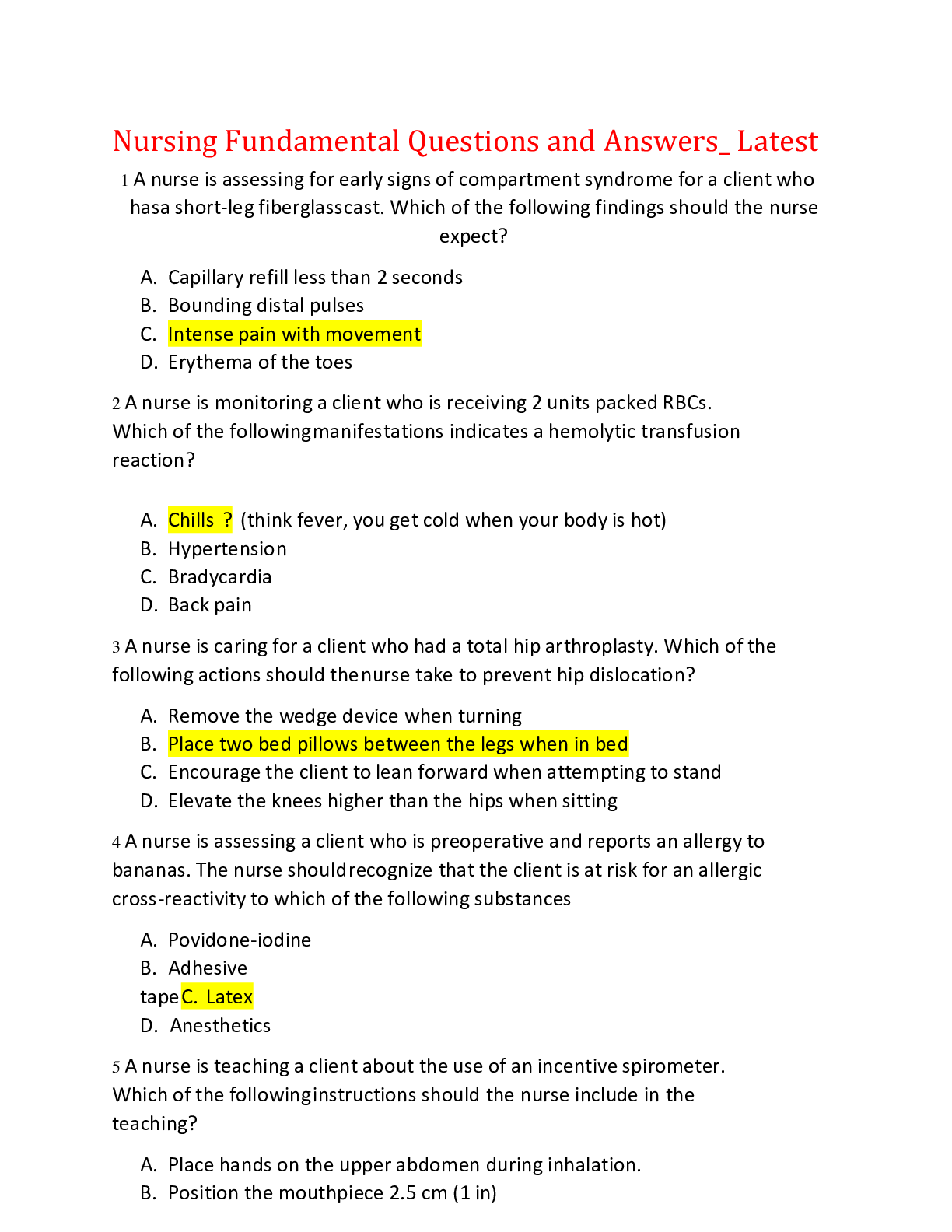
Reviews( 0 )
Document information
Connected school, study & course
About the document
Uploaded On
Sep 10, 2021
Number of pages
20
Written in
Additional information
This document has been written for:
Uploaded
Sep 10, 2021
Downloads
0
Views
99


